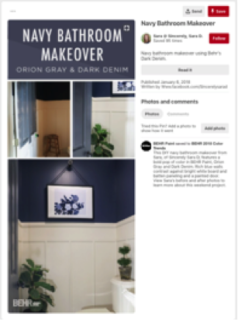Building Product Companies & Social Media Influencers
May 29, 2018
An in-depth review of the top building brands in social media reveals how brand relationships with influencers is changing.
After we released our exclusive report listing the top building brands in social media, we’ve talked about a few things those top brands are doing right: how they use passion points and user-generated-content. Now, let’s look at how they use social media influencers.
Influencers are social media users who’ve established credibility and can influence their following through their authentic virtues and approach. For most people, hearing the word “influencer” brings to mind celebrities, bloggers and vloggers, and Instagrammers with millions or hundreds of thousands of followers. And it’s not entirely wrong – this was the default used by most brands, especially early adopters.
But in reality, influencers today do not need global appeal or an enormous follower count. Exactly what constitutes an influencer is changing, thanks to:
- The proliferation of the social media landscape
- Tighter, much-needed FTC guidelines
- Increasing conformity of branded social content, and
- Users’ increasing distrust in large-scale social promotions
The changing definition of “Influencer”
Actually, we see brands having better earned content results by partnering with “micro-influencers” – users with modest followings but are established in a particular niche.
An “influencer” could also be… a customer. While they wouldn’t be considered as such by traditional standards, their genuine advocacy, approachability, and expertise has just as much power to influence.
There may be no better recent example of a building brand using customers as influencers than in Milwaukee Tool’s #LightTheSite, a social media series that is a poster child example for both user-generated-content and influencers.
In what started out as a contest in 2016 (from what we can tell), #LightTheSite has become a mainstay in Milwaukee Tool North America’s social content mix.

They collect photos from users who’ve shared posts using the hashtag and feature that UGC across their channels. (Our blog post here has more detail on why UGC is so incredibly important.)

We noticed they recently took it a step further by partnering with Colt from @Just_Build_It_ for and Instagram takeover. With a modest Instagram following of 13,800 and 56 Facebook fans (at the time of this post), this micro-influencer, customer and Milwaukee Tool advocate was given the proverbial keys to the Instagram account of the #1 building brand in social media.


How did it go? Well, see yourself:

Since #LighttheSite was started in 2016, 779 Instagram users have joined in by using the hashtag and the social media posts curated from @Just_Build_It_. They are among the top performing posts for the company.
Of course, they also feature well-known faces, more traditional influencers, much to their community’s delight:

(That’s actor Richard Karn, or as you may remember him, Al, from Home Improvement.)
But examples like this are few and far between for Milwaukee Tool. All good things in moderation, right? Overuse of celebrities and high-profile influencers would kill the organic community spirit and engagement they’ve worked hard to build. Their marketing team wisely values the strength of their community and shared passions over the “glitz and glamour” of a famous face.
The Long Shelf Life of Influencer Content
Let’s look at Benjamin Moore – one of the top 5 building industry brands in social media and no stranger to the influencer community. For more than half a decade, its use of influencers has been one reason it is touted as one of the best examples of social media success. For example, Benjamin Moore’s “For Those Who Know More” campaign, won awards and garnered spectacular media coverage. But, like campaigns do, they fizzle out and are replaced by new, shinier ones each year.
But… do they really fizzle out? Not always. Just like the saying goes, “What happens on the Internet stays on the Internet.” Beyond the reach and engagement, influencer content has an extraordinarily long shelf life on social media. We see this most often on YouTube and Pinterest. For now, we’ll focus on the latter.
These influencer pins about Benjamin Moore were published years ago – yet are still gaining traction, likely earning hundreds of thousands of repins and subsequential website visits – and purchases.
Can you say that for an email or TV spot?

Our last example is from BEHR Paint, # 5 on our Top 50 list. Currently, they have a healthy content mix combining 1) high-production value photography, 2) UGC and 3) micro-influencers.

Micro-influencers are a key source for brand content for BEHR. Take for example, their 2018 Color Trends sweepstakes, which accomplished several things including the ability to:
- Showcase organic, authentic photography that naturally resonates better on social media than any overly-produced brand content
- Create engagement with consumers, deepening the relationship
- Source and curate content from consumers that can be used in the future

Micro-influencers are a source for evergreen content, too. And that’s a good move – syndication across channels, like this by @SincerelySarahD (who has a little over 19,000 Facebook fans at the time of this posting), extends the life of BEHR’s earned content. It will live forever on blogs, Facebook, Instagram, Pinterest – and search engines:


Lessons learned
The power of influencers can’t be denied. But how, when, why, and who to work with can often be a challenge for many companies. Hopefully, you can take a few notes from the playbook of these brands by remembering:
- Content quality is in the eye of the beholder – users want organic, real, aspirational photography – not necessarily catalog-ready media.
- Syndicated influencer content has a long shelf life.
- When vetting influencers, consider their degree of authenticity, transparency and approachability as these factors determine how engaged audiences will be. That engagement is more important than follower count.
While we didn’t conduct in-depth content audits of all top 50 building brands, we did notice that the standout examples of influencer partnerships were from the brands in the top 10% of the list. There is a lot of room for growth – and nothing but opportunity lies ahead for the rest of the building industry.
Let us know if you need help in working with influencers – we excel in helping building product manufacturers design and execute stellar influencer marketing programs.




